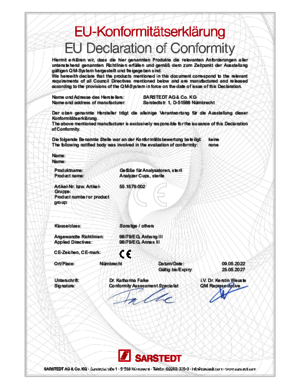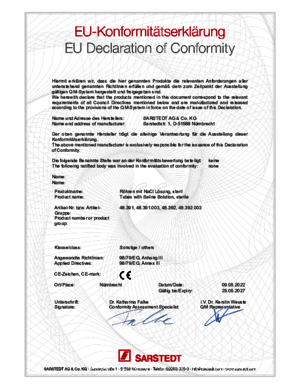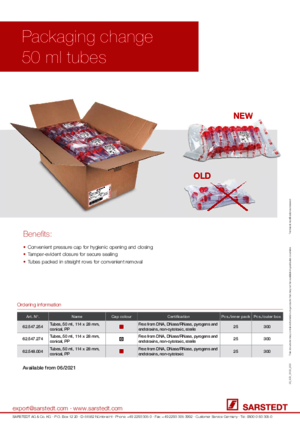
Packaging change 50 ml tubes
Packaging change 50 ml tubes
Language:
| Order number | 55.526.053 |
|---|---|
| Product description | Tube, working volume: 5 ml, (LxØ): 75 x 12 mm, material: PP, round base, transparent, push cap, suitable for Abbott m1000, 500 piece(s)/StackPack |
| Graduation | no |
|---|---|
| Closure type | push cap |
| Suitable for | Abbott m1000 |
| Base shape | round base |
| Volume of work | 5 ml |
| Centrifugation max (RCF) | 5000 x g |
| Diameter | 12 mm |
|---|---|
| Length of product | 75 mm |
| Product material | Polypropylene (PP) |
|---|---|
| Colour of product | transparent |
| Satisfies the requirement | sealed at 0.6 bar/10 min |
|---|---|
| Product category | In vitrodiagnostic device, CE |
| CE certified | CE |
| Batched | yes |
| Minimum order qty. | 2000 |
|---|---|
| Type of smallest subpackaging | StackPack |
| Piece(s) / inner box | 500 |
| Piece (s) / outer case | 2000 |
| Piece(s) / pallet | 48000 |
| Depth of case | 378 mm |
| Width of case | 375 mm |
| Height of case | 215 mm |
| Case volume | 0.0305 cbm |
| Weight of product | 0.0026 kg |
| Weight of case | 6 kg |
| EAN of inner box | 4038917109710 |
| EAN case | 4038917080033 |

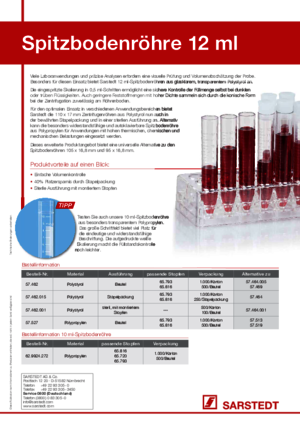
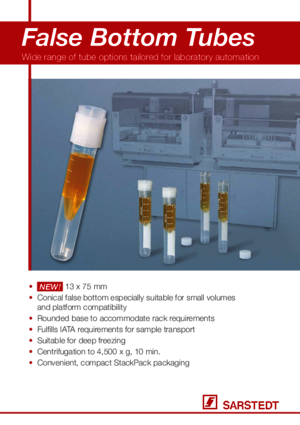
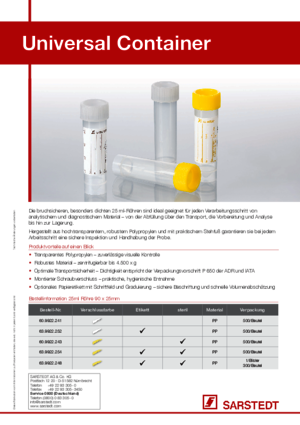
The scale on the 15 ml tubes has a volume tolerance of approx. +/- 100 µl, while the tolerance on the 50 ml tubes is +/- 250 µl.
The different types of tubes and materials used do not allow to make a general statement on this. You can find a more accurate statement on centrifugability in the product specifications for the respective item.
If reagent and centrifuge tubes are manufactured from polypropylene or polycarbonate, they can be autoclaved at 121°C without any appreciable loss of mechanical properties.
Due to their low temperature resistance, tube caps typically manufactured from polyethylene (PE) cannot be recommended for sterilisation by autoclaving. Screw caps made from polypropylene (PP) should be slightly loosened to prevent tube deformation caused by pressure and temperature changes during the autoclaving process.
The user must check whether other product characteristics are affected by autoclaving in terms of the desired use.
Products or product components manufactured from polyethylene (PE) cannot in principle be recommended for autoclaving at 121°C. This is due to the low temperature resistance of the PE plastic, which has a maximum long-term use temperature of 60–80°C. It is therefore not possible to rule out an impairment of the product. One example of such an impairment is geometric distortion, which can lead to leaks in tubes.
The use of PP tubes at temperatures below zero centigrade must be carefully tested under real conditions as the load on the tubes can be very different depending on the medium to be frozen and the routine conditions. We are able to give you some tips on the basis of our experience and tests we have carried out on PP tubes.
In principle, with products made of PP, the strength values are reduced at temperatures below 0°C, and it is therefore necessary to ensure that the frozen tubes are not exposed to any particular mechanical loads (e.g. do not let the tubes fall off the table). The freezing conditions must be selected such that the content can be evenly frozen or frozen from the bottom to the top. Cracks caused by strain can occur in the lower part if the upper part of the tube freezes first as a result of unfavourable freezing conditions. For example, depending on the diameter of the hole, stands made out of Styrofoam have a strongly insulating effect which makes it more difficult to ensure the even freezing of the tubes. In principle, the tubes should have sufficient room to expand in a stand or storage container. Due to the large number of possible influence factors, we recommend you carry out a freezing test under your routine conditions.





